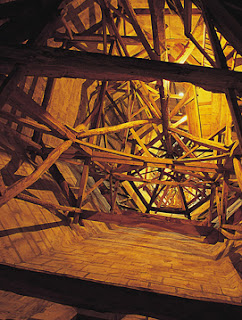Approaching the Salisbury Cathedral, the magnificent spire seems to pierce the blue canopy above, reaching for the heavens. It is Britain’s highest at 404 feet, and certainly the most graceful. The Cathedral’s website is here.
Officially named the Cathedral Church of the Blessed Virgin Mary, it is more than 750 years old, completed in 1258, after just 38 years of construction, almost a miracle in the day. The rapidity of completion also ensured that Salisbury Cathedral is basically one style, the Early English Gothic; many cathedrals had several generations of builders involved, bringing evolving styles to their construction.
The tower and spire were added somewhat after the main structure was finish. Visitors may climb the 330-plus steps into the tower to the base of the spire, which gives an excellent view of the interior construction of medieval days.
Though art and religious historians have tried to explain to the contemporary visitor just what a cathedral was, its symbolic role and its functions as a religious and community center, it is difficult for us to grasp just what these amazing buildings meant in medieval society.
The novel Pillars of the Earth by Ken Follett provides a fictional account of the building of a great cathedral, roughly based on Salisbury. It was presented as a television miniseries in 2010, and it is well worth watching.
In addition to the book and tv versions, an expanded and amplified interactive editions is available for download to your iPad or other mobile device. For a preview, click here.
Novelist Susan Howatch also set a series of novels in the cathedral community of Starbridge, also modeled on Salisbury, though in the 20th century. There are six novels in the series, beginning with Glittering Images.
Salisbury Cathedral, with the largest cathedral close (precinct) in England and also the largest cloister, is a major tourist attraction in Wiltshire, competing with the nearby stone circles at Stonehenge and Avebury, Old Sarum, stately homes such as Wilton House and Bowood, the Safari Park at Longleat, and extensive gardens such as at Stourhead. In addition to the building and its art, one of four existing copies of the Magna Carta is on exhibit in the Cathedral’s Chapter House.
The Magna Carta was signed in 1215 by King John; it provides a foundation for democratic values in removing absolute power from kings and providing for liberty under the law.
John Constable, brilliant painter — particularly of landscapes — painted Salisbury Cathedral many times. Versions exist in many of Britain’s major museums as well as in several in the U.S.






















Lovely piece on one of my favourite places. Feel very privileged each time we visit it.
Also, the book Sarum by Edmund Rutherfurd is a good, Michener style, account of the development of the town and the building of the cathedral.